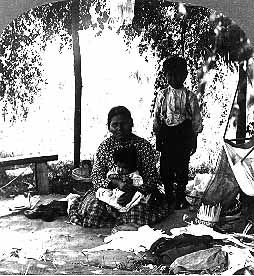

Title: Native family on Prince Edward Island
Date: ca. 1903
PHOTOGRAPHER: Unknown
National Archives of Canada, negative no. PA-024868
The Aborigines Protection Society was founded in England in 1838. Composed primarily of wealthy men, the Society's purpose was to keep informed of the state of aboriginal societies mainly in North America and where possible to improve their plight. Its interests were world-wide and often concerned native populations in the United States, but on occasion the Society attempted to provide support to Indians in Canada. In 1870, the Aborigines Protection Society was instrumental in establishing a reserve of land on Lennox island, just off the coast of Prince Edward island, at a time when the Micmacs in the colony were in danger of being decimated. Most Indian reservations have been established by government through treaties with Indians, not through the purchase of land by a benevolent organisation. In 1767 the entire island was divided into 66 large lots and given by the British government to a group of proprietors. Even had the colonial government of Prince Edward Island wished to negotiate with the resident Micmacs for the creation of a reserve, it had no crown land to use for that purpose. At no time during the nineteenth century was the Micmac population likely greater than three hundred. They simply were not considered a significant enough problem to occupy the colonial government. From the early 1800's, some Micmacs had taken up at least seasonal residence on Lennox Island, which actually belonged to Sir James Montgomery of London. The island was sold in 1830 to David Stewart. The Micmac families began to lobby the colonial government to purchase a reserve for them. The colonial government was unwilling to pay. Little changed until 1862, when Theophilus Stewart decided to contact the Aborigines Protection society and requested support for the Island's native population. By 1870, the Society had purchased Lennox Island and set it aside for the use of the Indians of Prince Edward Island. In 1873 Prince Edward Island entered Confederation and responsibility for the native population fell to the federal government in Ottawa. The Annual Report of the Department of Indian Affairs for 1875 includes a report by Stewart in which he indicates his optimism for the general improvement of the Indians on the Island. In 1911 the Secretary and Assistant Deputy Minister of the Department of Indian Affairs, J.D. McLean, contacted the Anti-Slavery and Aborigines Protection Society (the Aborigines Protection Society amalgamated in 1909 with the British and foreign Anti-Slavery Society) to request the transfer of title of Lennox Island from the Society to the Crown. The Department of Indian Affairs had finally decided that Lennox Island should be a reserve similar to the others it administered. From the letter written by the Society's secretary, Francis Buxton, to McLean, it seems the Society had paid little attention to the Indians of Prince Edward Island in the forty years following their purchase of Lennox Island. The deed of Lennox Island was to be made over to the Crown excited as least one of the elderly board members. Horne Payne was adamant that the three living members of the Board of trustees appoint new board members before any negotiations be entered into with the Department of Indian Affairs on behalf of the Crown. Francis Fox was under the mistaken impression that the Anti-Slavery and Aborigines Protection Society actually owned Prince Edward Island in its entirety! The land reverted to the Crown on June 12, 1912. While the society's purchase of the land for a reservation was a generous and indeed a helpful act, the members of the society probably had only a passing interest in the actual individuals toward which their charity was directed. Nonetheless, because Lennox island was purchased for the resident Indians in 1870, it is likely that the very existence of the reserve strengthened the position of the Micmacs with the department of Indian Affairs when the federal government assumed responsibility for Indian Affairs in 1953.
Nancy McMahon